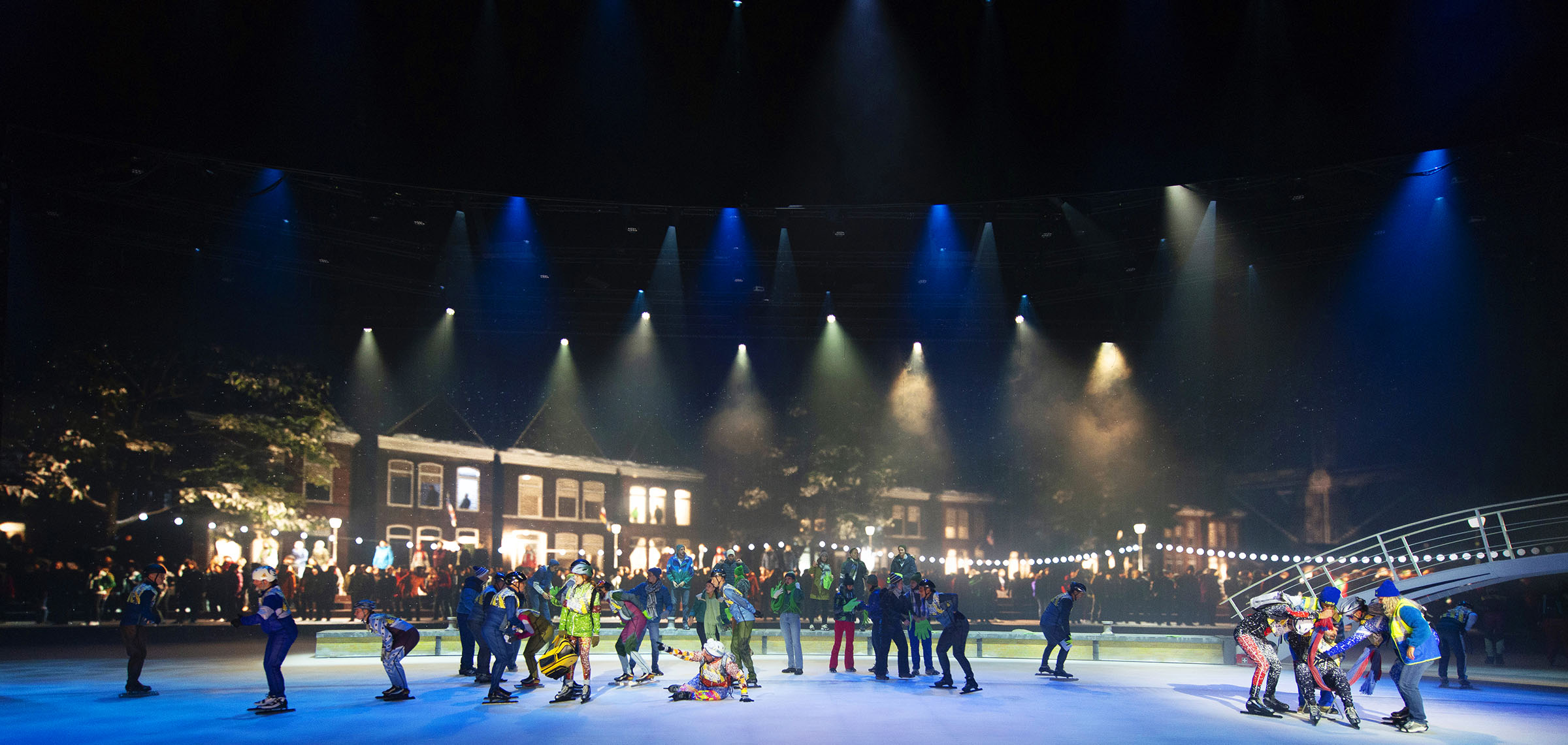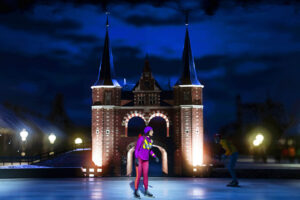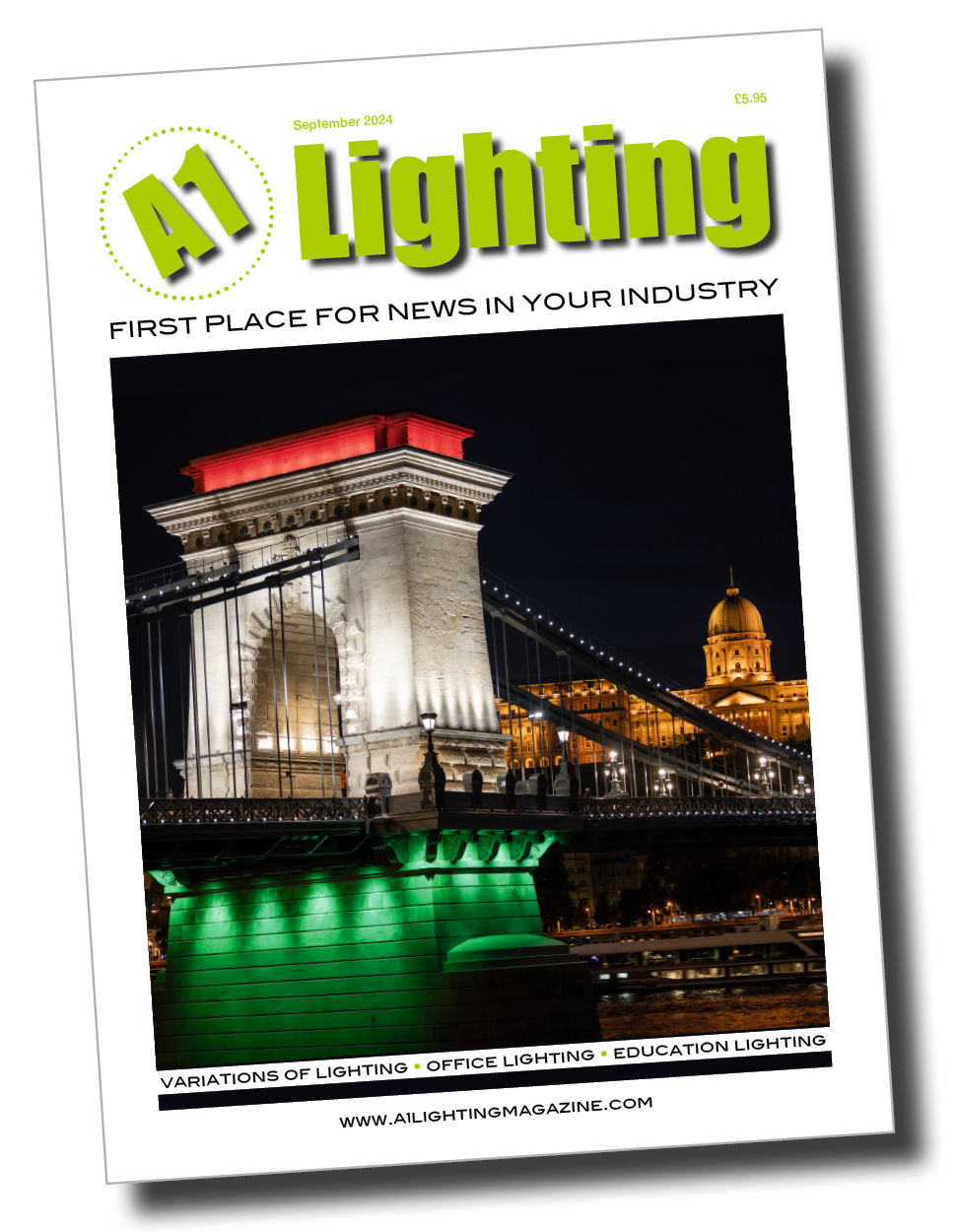
De Tocht is an exciting new ice-based musical production staged in the purpose-built 1475-capacity Friso Theater in Leeuwarden, the Netherlands. Directed by Eddy Habbema and choreographed by Marc Forno, the production design was created by Luc Peumans, artistic director of Painting with Light (PWL), whose brief encompassed lighting, video and scenography, an ambitious collage of visual disciplines to capture all the skating action presented in “spectacular” style.
Luc utilized over 200 Robe moving lights for the show including 120 x ESPRITES, 83 x LEDBeam 350s, 16 x T2 Profiles and 13 x iFORTES running on a remote follow spot system, supplied to the production by RentAll.
The Dutch-language De Tocht story follows five former skating friends on their adventures skating the Elfstedentocht – an 11-city, 200 km long-distance tour on natural ice over rivers and canals in the Netherlands, which is both a speed skating competition with 300 contestants and a leisure tour with around 16,000 skaters at the start. The last time it was run was in 1997.
Luc worked closely with set designer Jo Segers. He had initially started discussing the show around five years ago with figure skater Madelène Van Beuzekom who he knew through past “Holiday on Ice” productions, and who was one of the instigators of the De Tocht concept. The show was postponed twice due to Covid before finally being premiered in October this year to outstanding reviews.
The staging features a 60-metre-wide by 6-metre-deep bespoke revolving ice trackweighing 140 tons, offering up – with the stage area included – 2000 square metres of ice. The ice revolve was built by creative engineering specialist, Mannen van Staal from Leeuwarden and a seating tribune sits in the middle of this innovative staging concept, offering 270-degree viewing of a stage at one end.
The stage is at one end of the venue, with a 52-metre-wide by 7.2-metre-high LED screen in front which splits open in four sections that track horizontally to reveal the stage behind. These sections move into different configurations to support the action happening on the revolve.
At the back of the stage is another screen, this one measuring 41 metres wide and 8 metres high, so with the front screen open and two sections flanking each side of the stage, the total screen area spans an impressive 93 metres!
This presents an 18000-pixel wide vista for the audience and delivers the stunning Impressionist-inspired digital scenery and backdrops that the PWL team has devised for the project.
To stand out in this massive LED environment, Luc needed super bright and clearly defined fixtures … So, he was delighted to be able to utilise all the Robe elements and the ESPRITES in particular, which are the backbone of the lighting scheme.
The front half of the revolve is all performance space while the 180 degrees behind the seating tribune comprises backstage and technical areas. A feat of engineering in its own right, in conjunction with smart video content, the revolve was vital for narrative details like the impression of speed and motion. It also enabled props to be seamlessly moved into and out of the performance space.
While the show design was originally planned to have projections – the newest ‘dark black’ screens were not yet available in 2018 – so after some wrangling, it was decided to go with LED screens supplied by Faber Audiovisuals.
Luc then found himself needing more lighting for projection onto the ice, which also led to his choice of very flexible fixtures like the ESPRITE.
The lights are rigged on a series of curved and straight trusses installed in the roof above the seating tribune and over the stage and ice.
As well as projecting onto the ice, with the addition of four custom gobos designed by PWL, the ESPRITES add texturing to the ice to make it appear more natural and match effortlessly with the video content. These fixtures also double up as front, top and back light. “They are used in a proper multifunctional context,” noted Luc.
They are paired with the LEDBeam 350s which are used in both spot and wash mode, and to produce most of the general stage washes. Luc likes their small size, serious punch, and general usefulness – “they are such handy little fixtures.”
Four side ladders each side of the stage provide boom positions, which are rigged with more LEDBeam 350s and T2 Profiles.
Each boom ladder has 2 x T2s and a pair of LEDBeam 350s plus a smoke machine and fan to boost the atmosphere. Luc highlights that ‘active smoke management’ plays an important role in the overall design.

With just shy of 400 luminaires in the main lighting rig and the large quantities of LED, key lighting and follow spotting were critical, so he chose to work with 13 x Robe iFORTE FollowSpots rigged above the seating tribune, operated via a remote hybrid manual / automated system.
Thirty-five other fixtures were also connected to the following system which is triggered either automatically via trackers worn by the cast or undertaken manually by two remote operators.
Luc loves the quality and look of the iFORTE light output and the refined key lighting it brings to the production together with colour temperature control and other dynamic features.
The key light tracking positional information is also used to mask the video content in the disguise gx 2c media servers, allowing the digital content to move in unison with the skaters staying in perspective, which is vital when they are moving, also going in the right direction when skating left to right or vice versa, keeping the background parallax correct.
Crisp key lighting further enabled Luc and the video content team led by Menno Broere to add more cinematic touches to the content with blur and bokeh, all of which look very cool.
The Impressionistic aesthetic for lighting and video content was developed first as a series of mood boards with a scale model at PWL’s HQ in Genk.
Lighting was programmed on a grandMA3 console by PWL’s Stijn Vanholzaets and Matthijs van Hulsentop during the technical and rehearsal sessions.
Stijn was dealing with the main show lighting while Matthijs programmed the remote spotting system. Niels Huybrechts was the associate LD. The media servers were programmed by Toon Raskin, and the remote follow system was maintained by Rik van de Weerthof.
Once all the lighting and video programming and fine-tuning were completed, operation was handed over to the producers’ show run crew.
Luc mentions that while they had the unusual luxury – due to the postponements – of plenty of time to think in advance before the production was finally green-lighted, once on site and in situ, they needed to be as adaptable as possible and accommodate numerous changes as the final details were blocked.
He and the PWL team used the 18 months before to engage in rigorous preparation as they arrived on site very well organised and able to fully maximise their time there.
Working on all visual aspects of the production brought the huge bonus of being able to see digital content immediately which speeded up the process, as they could assess and know immediately this needed lighting.
“There was a lot of teamwork involved both internally and externally and it was great to collaborate as always – it’s the best way to work!” stated Luc. “I think we all enjoyed being a] part of staging such a groundbreaking and entertaining performance which our audiences are loving!”
De Tocht is almost already completely sold out, and is currently scheduled to run until the end of April 2024.
Photos by Joris van Bennekom.













